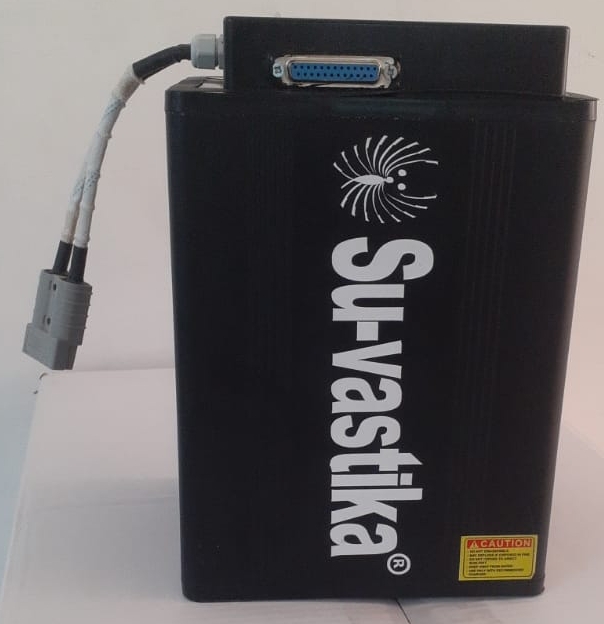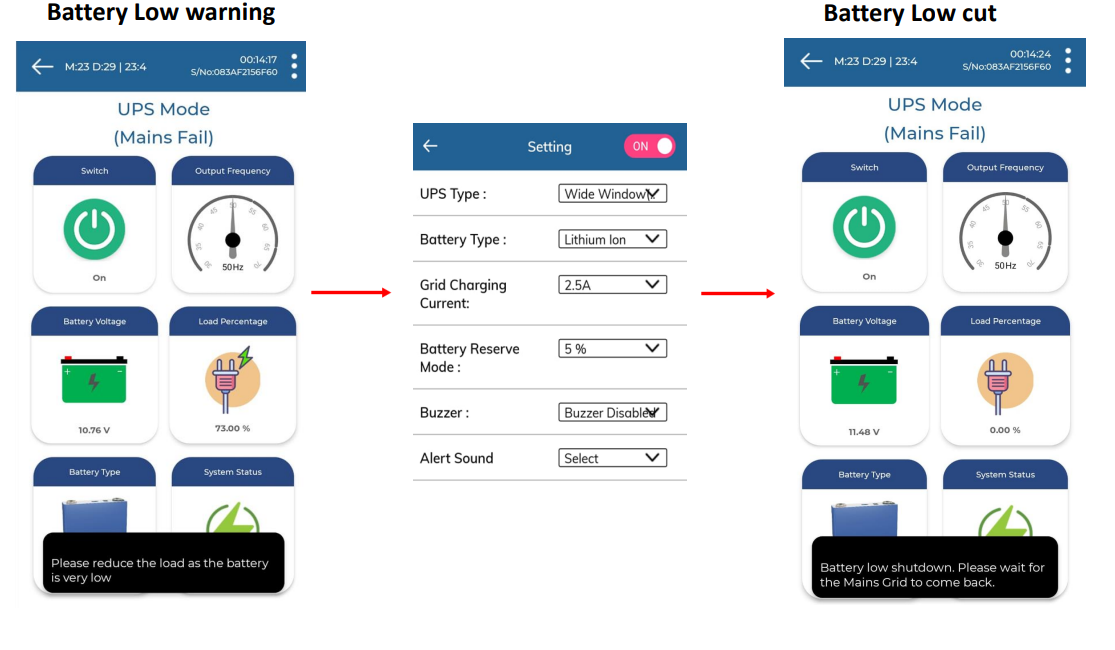How to Choose the Right Low Voltage Battery Cutoff (LVC)
How to Choose the Right Low Voltage Battery Cutoff (LVC) in Inverter/UPS is a very important parameter to understand. A low-voltage battery cutoff (LVC) is a device or feature inside the Inverter/UPS that disconnects a battery from a load when the voltage drops below a certain level. This helps to prevent the battery from being deeply discharged, which can damage the battery.https://en.wikipedia.org/wiki/Cutoff_voltage
The LVC is typically 10% below the battery’s nominal voltage. For example, a 12V Tubular lead Acid battery might have an LVC of 10.8V. This means the LVC will disconnect the battery from the Load when the voltage drops to 10.8V. For the lithium battery, this cutoff is at higher voltages as the Lithium battery LifePo4 has a voltage of 12.8 Volts, so the cutoff voltage for a Low battery is 11.2 Volts. This voltage keeps the Lithium battery safe because the BMS inside the battery keeps working. The battery voltage is reduced until BMS switches off, generally switched off at around 9.5 Volts. If the Mains power takes a long time to come back, the lithium battery might go to deep discharge as the BMS keeps taking the current and taking the battery below a certain level from where the battery needs an external charger to charge.https://www.researchgate.net/figure/Schematic-diagram-for-low-battery-cut-off-The-inverter-feedback-section-maintains-a_fig7_264158214
What is the difference between a low-voltage battery cutoff for a lead acid battery versus a lithium battery?
The Low Battery voltage cutoff in the lead Acid is kept at 10.5 Volts to keep it safe. The low cutoff voltage for the 3.2 Volt lithium battery cell of LifePO4, having a 12.8-volt battery, is kept at 11.2 volts as the built BMS keep taking the current during the ideal condition of the battery, so to keep it safe, its recommended to keep it 11.2 volts.

Lithium battery pic



How does the low-voltage battery cutoff work in the Su-vastika Inverter/UPS?
In Su-vastika Pure Sinewave UPS with ATC model, we can use Lead Acid batteries like Tubular, SMF and gel batteries and the option of using Lithium battery LifePo4 chemistry. Also, there is an option to change the LVC to 4 preset voltages like 10.5, a default voltage setting, along with the 10.8, 11.0 and 11.2 Volts.
This is shown in the mobile application as battery Reserve Mode settings which start from 0%,3%, 5%,8% and 10%. So 0% is 10.5V, 3% is 10.8, denotes 5%, and 11.2 is 8%.
The higher the Low Voltage settings, the better the battery life because the DOD can be reduced in this case, and the lower the DOD in the battery, the higher the life of any battery.
This feature also helps the user as it works like reserve in a scooter. If the user sets the reserve mode to 8% and when the Inverter/UPS battery stops after giving it back up, the user can change the setting to 0% and get back up from the battery as it was reserved in the battery.https://suvastika.com/lvc-low-voltage-cutoff-and-its-significance-for-batteries/
There is a mobile app from where you can do the settings in the setting section, and the moment the user selects any battery, the picture of that battery will be visible all the time so that the user can correct it in case he did the wrong setting. The moment the customer chooses the Lithium battery, the Lithium battery’s low voltage cutoff is automatically selected, which is kept at 11.2 volts.
If you are considering using battery reserve mode, you should weigh the benefits against the drawbacks. The main drawback of battery reserve mode is that it will reduce the power you can use from your battery. If you have a large battery, this may not be a problem. However, you may consider setting a lower reserve level if you have a small battery.



In Su-vastika Inverter/ UPS, the warning for low battery starts at 10.8 volts, and this gives a warning with audio and LCD/LED messages. If the user can reduce the Load, then this warning goes off as the battery voltage is recovered if the Load is reduced. But when the battery is almost discharged, then at a smaller load, this warning comes, and even if the user reduces the Load, it will come to 10.5 Volts and then switch off the Inverter/UPS till the Mains Power come back. Most of our inverters/UPS/Solar inverters/PCU give you a Low battery alert four times. If the user doesn’t reduce the Load during that time, it goes to Low battery cutoff mode, and the user has to reset the front switch of the inverter to restart the inverter functioning by reducing the Load. In Su-vastika UPS, there is a provision to add WiFI or Bluetooth to the UPS, and then at the mobile app user can see the low Voltage warning and can reduce the Load as the mobile app gives the sign of Low battery and the Load is switched on and off for three times and during that period if the user reduces the Load than it stop this warning for some more time and continue functioning. But once the battery is very low than at a smaller load, also it gives the warning and switches off the Load to save the battery from going to deep discharge.
Here are some of the benefits of using a low-voltage battery cutoff:
- It prevents the battery from being deeply discharged, which can damage the battery.
- The LVC is different for Lead Acid batteries and Lithium batteries.
- How does the low-voltage battery cutoff work in the Su-vastika Inverter/UPS/Solar Inverters/PCU
- The higher the settings for reserve mode, the life of the battery will increase.
- The Reserve mode helps the user get more backups in an emergency.
How to Choose the Right Low-Voltage Battery Cutoff (LVC) for Inverter/UPS The life of the battery is enhanced If you use a battery in a critical application, a low-voltage battery cutoff is essential. This will help to protect the battery from damage and extend its life.
Written by Kunwer Sachdev https://g.co/kgs/JFLwWN




I’m not sure where you are getting your info, but great topic.I needs to spend some time learning more or understanding more.Thanks for wonderful information I was looking for this info for mymission.
Great article. I will be going through many of these issues as well..
I am not sure where you’re getting your info, but good topic. I needs to spend some time learning more or understanding more. Thanks for magnificent information I was looking for this info for my mission.
Hey, thanks for the post.Really looking forward to read more. Keep writing.
I appreciate you sharing this blog.Really looking forward to read more. Cool.
I think this is a real great article.Really thank you!
Wonderful blog! I found it while searching on Yahoo News.Do you have any suggestions on how to get listed in YahooNews? I’ve been trying for a while but I never seem to get there!Cheers
Hey, thanks for the blog article.Thanks Again. Really Great.
Very informative blog article.Really thank you! Keep writing.
I value the blog article. Awesome.
Major thankies for the article. Cool.
I do consider all of the concepts you’ve presented for your post. They are really convincing and can definitely work. Still, the posts are too short for novices. Could you please extend them a little from subsequent time? Thank you for the post.
Way too many blog owners nowadays however just a few have articles worth spending time on reading.
Highly descriptive article, I loved that a lot. Will there be a part 2?
Hi, I check your blog regularly. Your humoristic styleis awesome, keep doing what you’re doing!
A fascinating discussion is definitely worth comment. I do think that you need to write more about this subject matter, it might not be a taboo subject but typically folks don’t speak about such topics. To the next! Cheers!!
Amazing! Its genuinely amazing article, I have gotmuch clear idea about from this post.My blog post – stop smoking weed today
I do consider all of the ideas you’ve introduced in your post.They are really convincing and can certainly work. Still, the posts are very quick for novices.Could you please extend them a little from next time?Thanks for the post.
Hi there, just wanted to say, I loved this blog post.It was funny. Keep on posting!
I dugg some of you post as I thought they were very helpful extremely helpful
I love reading through a post that can make people think. Also, thanks for allowing for me to comment.
wow, awesome post.Much thanks again. Really Cool.
I cannot thank you enough for the post.Really looking forward to read more. Awesome.
Wonderful blog! I found it while browsing on YahooNews. Do you have any tips on how to get listed in YahooNews? I’ve been trying for a while but I never seem to get there!Many thanks
thanks for the comments I don’t know.
There’s definately a lot to know about this issue. I love all the points you’ve made.
It’s a different perspective, thank you for your hands.
Hello, everything is going nicely here and ofcourse every one is sharing data, that’s actually excellent, keep up writing.
I really like and appreciate your post. Awesome.
You made some clear points there. I did a search on the subject and found most persons will go along with with your blog.
A round of applause for your article.Thanks Again. Great.
You could definitely see your enthusiasm in the work you write. The world hopes for even more passionate writers like you who aren’t afraid to say how they believe. Always go after your heart.
I want to to thank you for this very good read!! I definitelyloved every bit of it. I have you book-marked to look at newthings you post…
Heya i am for the first time here. I came across thisboard and I find It truly useful & it helped me out a lot.I hope to give something back and help others likeyou aided me.